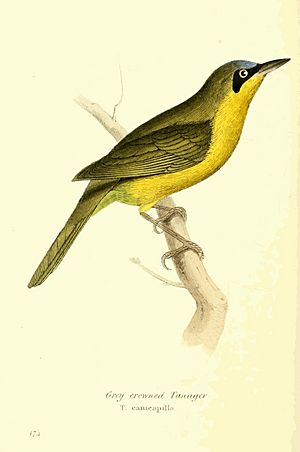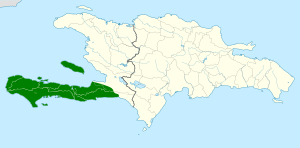Grey-crowned tanager facts for kids
Quick facts for kids Grey-crowned tanager |
|
|---|---|
 |
|
| Conservation status | |
| Scientific classification | |
| Genus: |
Phaenicophilus
|
| Species: |
poliocephalus
|
 |
|
| Range in green | |
The grey-crowned tanager is a special kind of bird found only on the Caribbean island of Hispaniola. This island is shared by two countries: the Dominican Republic and Haiti. It's also called the grey-crowned palm-tanager. Scientists call it Phaenicophilus poliocephalus. This bird is currently listed as a Near Threatened species, which means it could become endangered if we don't protect it.
Contents
About the Grey-crowned Tanager
Bird Family and Relatives
The grey-crowned tanager belongs to a bird family called Phaenicophilidae. These are known as the Hispaniolan tanagers. It shares its group, or genus, with another bird called the black-crowned tanager. Sometimes, these two birds even have babies together!
Scientists have studied this bird for a long time. In 2017, they decided to move it to its own special family. There are three types, or subspecies, of the grey-crowned tanager. These are P. p. poliocephalus, P. p. coryi, and P. p. tetraopes.
What Does It Look Like?
The grey-crowned tanager is about 18 centimeters (7 inches) long. It weighs around 27 grams (1 ounce), which is about as much as a few coins. Both male and female birds look very similar.
This bird has a deep gray top of its head, like a crown. It also has a black "mask" around its eyes. There are cool white spots in front of, above, and below each eye. Its back and wings are a pretty yellow-green color. The throat is bright white, and the rest of its belly is the same dark gray as its crown.
Some of the subspecies look a bit different. The P. p. coryi is bigger and has lighter colors. It also has a white stripe down its chest and belly. The P. p. tetraopes is a little lighter than the main type.
Where Does It Live?
The grey-crowned tanager lives only on the island of Hispaniola. The main type, P. p. poliocephalus, is found in southwestern Haiti. It also lives on a small island called Grande Cayemite. In the Dominican Republic, you might see it in the Sierra de Baoruco mountains. It also lives in the southern parts of Loma de Toro and Hoyo de Pelempito.
Another subspecies, P. p. coryi, lives only on Île-à-Vache. This is an island off Haiti's southern coast. The P. p. tetraopes subspecies lives only on Gonâve Island. This island is in the Gulf of Gonâve.
These birds are not picky about where they live. They can be found in many types of forests. This includes dry forests, wet forests, and even open or dense areas. You might also spot them in tree farms, gardens, and city parks. They live from sea level up to high mountains, about 2,400 meters (7,900 feet) high.
Behavior and Life
Movement and Daily Life
The grey-crowned tanager stays in the same area all year long. It does not fly to different places during different seasons.
What Does It Eat?
These birds usually look for food in pairs or small family groups. They search from the middle of the trees up to the very top. Sometimes, they even join other types of birds to find food together.
Their main food is small arthropods, like insects and spiders. They also eat some fruit. They find insects mostly by picking them off leaves, both living and dead.
Reproduction and Family Life
The grey-crowned tanager's breeding season is from May to July. During this time, they build a cup-shaped nest. They make it from small twigs. The nest is usually built high up in a tree, about 9 meters (30 feet) off the ground.
A female bird usually lays two to four eggs. After the young birds hatch and learn to fly, the family stays together for several months. Scientists are still learning more about how these birds raise their young.
Bird Calls and Songs
The grey-crowned tanager has a long, pretty song. It also makes a call that sounds like "peee-u". It can be hard to find recordings of their sounds, but scientists are working to get more.
Conservation Status
The grey-crowned tanager is listed as "Near Threatened" by the IUCN. This means it's not endangered yet, but it could be in danger soon. The bird lives in a small area, and its population size is not fully known. However, scientists believe its numbers are going down.
One big problem for these birds is deforestation. This is when forests are cut down. It's happening a lot in the Dominican Republic and especially in Haiti. Even though their habitat is shrinking, these birds are still common in the areas where forests remain. They are also good at living in different kinds of places, which helps them survive.
See also
 In Spanish: Cuatro ojos coronigrís para niños
In Spanish: Cuatro ojos coronigrís para niños


